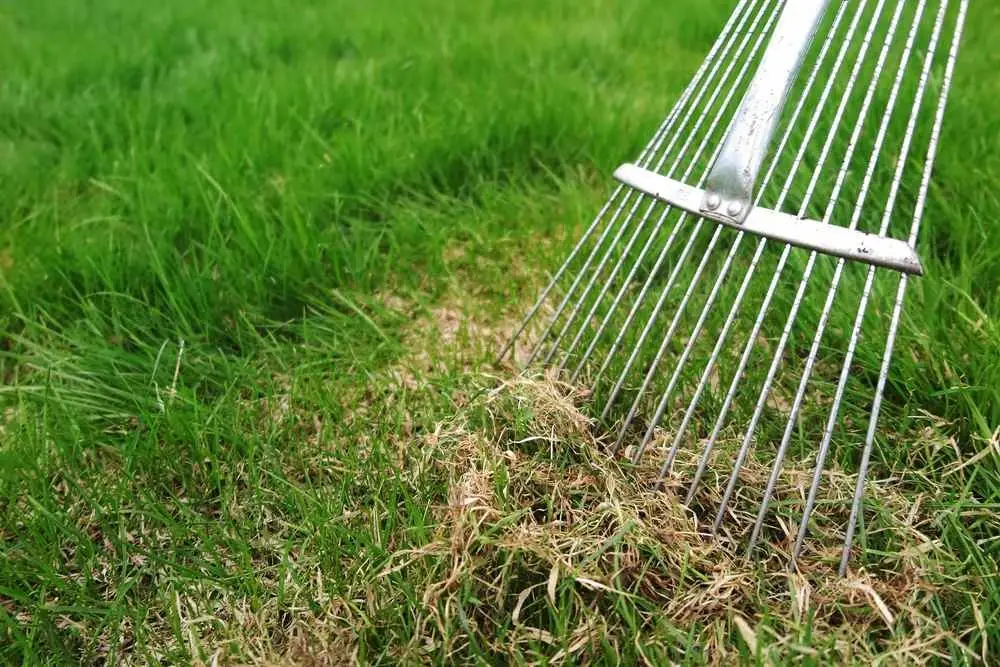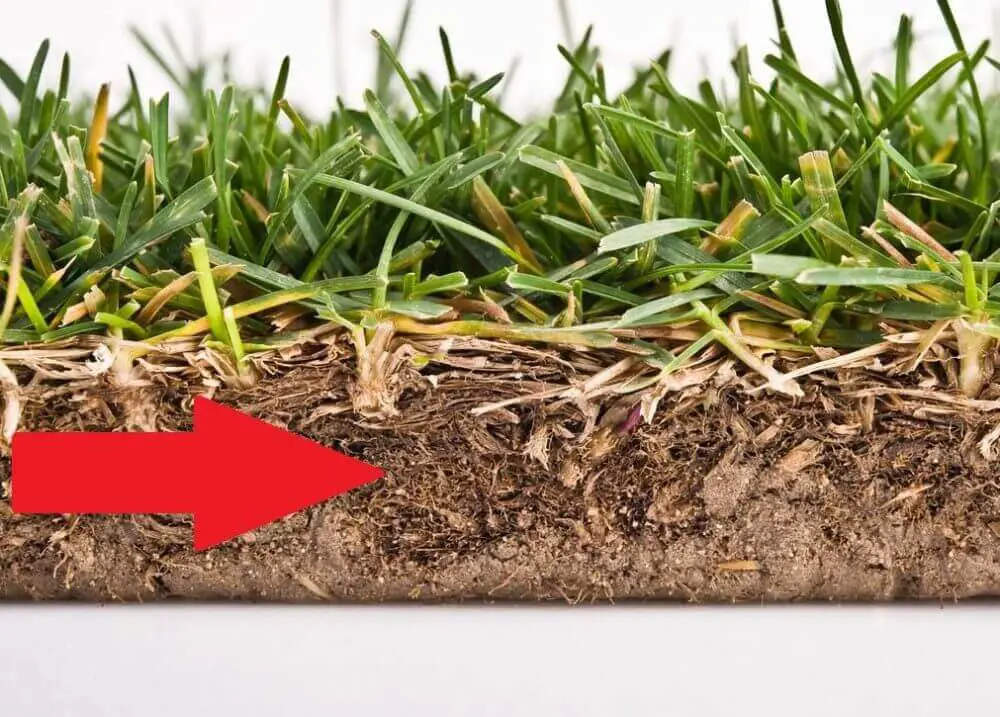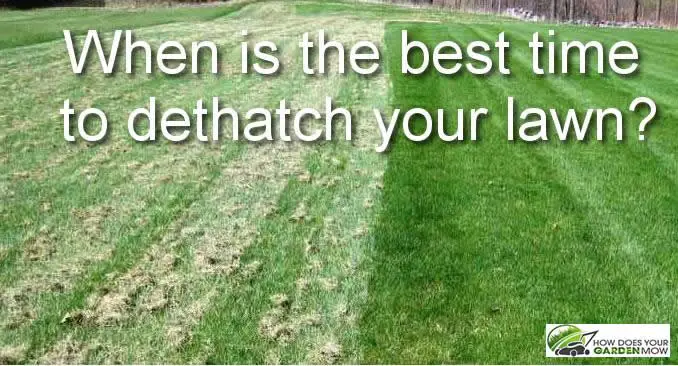What Is Lawn Thatch
Lawn thatch is a fibrous layer of predominantly dead and some living grass roots, stems and runners. This layer lies between leaves of the grass plant above the surface, and the root system below.
It is broken down and decomposed naturally by microbes, bacteria and fungi in the soil.
In an ideal world, it would break down at the same rate at which new grass grows and therefore, it should never cause a problem.
However, thatch contains a chemical compound called Lignin which is slow to break down. Unless conditions are perfect, which they rarely are, new grass often grows more quickly than the dead material is broken down and so it builds up.
How To Know If Your Lawn Needs Dethatching
This article was co-authored by Jeremy Yamaguchi. Jeremy Yamaguchi is a Lawn Care Specialist and the Founder/CEO of Lawn Love, a digital marketplace for lawn care and gardening services. Jeremy provides instant satellite quotes and can coordinate service from a smartphone or web browser. The company has raised funding from notable investors like Y Combinator, Joe Montana, Alexis Ohanian, Barbara Corcoran and others. This article has been viewed 27,730 times.
Thatch is the layer of dead grass, roots, and leaves between the grass and the soil. Thatch is important for drainage and moisture retention, but thatch that gets too thick is bad for the grass. Perform a few simple tests to see whether or not your thatch has gotten too thick. A general rule is that thatch should be less than ¾ inch thick.
Essence Of Dethatching Lawns
Here are the essence of dethatching your lawns:
- It allows fertilizer to go straight to the soil
- It enables the new seed to get in contact with the soil when overseeding the lawn field
- It allows better transfer of oxygen in-between the lawns.
- It also increases the health condition of the lawn by becoming more greenish.
One of the important parts of dethatching is to clean up the debris after aerating and leave the thatch plugs on your lawn.
You May Like: What Is Rgs For Lawns
Dethatching As Part Of Lawn Care
When prevention fails, the solution lies in dethatching. “Dethatching” a lawn refers to the mechanical removal from a lawn of a thatch layer that is too thick. Dethatching is not nearly as big a part of lawn care as is mowing. In fact, some homeowners may never need to dethatch the lawn. Some types of grass simply are not as susceptible to thatch build-up as others. For example:
- While Kentucky bluegrass is one of the cool-season grasses prone to developing too much thatch, tall fescue grass is far less susceptible.
- Among the warm-season grasses, you are more likely to have to dethatch Bermudagrass than zoysiagrass .
But when thatch does become a problem in a lawn, you should not overlook the importance of dealing with it, because the long-term health of your grass hinges on your finding a solution. The solution can take either of two forms: dethatching or core aeration.
Scarify And Rake Your Lawn

Scarifying and raking physically removes thatch, dead foliage and moss from your lawn.
Scarifying is important as it removes thatch from around the base of the grass plants which allows are, water and nutrients back into the soil.
Raking controls the build-up of thatch by removing dead foliage and growth from the surface.
The best scarifiers often have changeable cartridges with vertical blades for dislodging thatch and spring tines for controlling thatch and moss from above the surface.
Its important that you choose the right time to scarify and this guide shows you how to scarify a lawn, step-by-step.
Also Check: Lines In Grass
How Do I Know If I Need To Dethatch
If you have a serious thatch problem, it is usually evident just by walking on the lawn. If your lawn feels very springy and crunchy underfoot, you most likely have a thick layer of thatch lurking under the grass.The best way to test the thatch accumulation is to remove and inspect a plug from your lawn. Using a hand shovel, remove a 2-3 thick plug of sod. If upon examination you see more than ½ inch of spongy, dry brown material, its time to dethatch. Note that many warm-season grasses such as Zoysia, Bermuda, St. Augustine and Buffalo grass are particularly prone to thatch buildup.
The Best Time To Dethatch
The period of active growth and warming temperatures of spring are ideal for dethatching, but exactly when in spring depends on the type of turf you have.
Both warm-season and cold-season turf types should be dethatched after they are actively growing. A general rule of thumb is to wait until they have been mowed a couple of times. For warm-season turf, this typically happens in late spring to early summer. For cold-season turf, the right time is usually early spring. Cold-season grasses can also be de-thatched in early fall while the grass is still growing, as it needs time to re-establish before the frost season.
Common warm-season grasses include Zoysia, St. Augustine, Bermuda, Bahia and Centipede. Common cold-season grasses include Kentucky bluegrass, rough bluegrass, fescue, and ryegrass.
Recommended Reading: Killing Speedwell In Lawns
What Is The Best Way To Dethatch My Lawn
To dethatch your lawn, you can either do it by yourself or you contact an expert.
If you want to dethatch your lawn by yourself, just get a rake and a dethatcher to get the work done.
Get a work-glove to wear on your hands.
Use the dethatcher to get the environment ready and use the rake to gather the thatch. After the gathering, pick up the thatch to put them in the garbage bag.
When To Dethatch Your Lawn
Prior to jumping into a dethatching project, its always best to assess your grass and determine whether the current thatch levels are healthy or not. The easiest way to do this is by taking a trowel, cutting out a small wedge of your lawn, and pulling it out for measurement and review. If the thatch is less than a ½ inch thick, dont worry about it. If its 1-2 inches thick , youve probably already started to see some lawn discoloration and weakness, and its certainly time to get your lawn dethatched.
Similar to other lawn and plant projects, its best to coincide your efforts with the optimal growth season. This will ensure that your lawn has the best odds of making a quick recovery to full health. If you have cool-season grass, such as Kentucky Bluegrass or Bentgrass, your optimal thatching time will be late summer to early fall. If you have warm-season grass, such as Bermudagrass or Centipedegrass, your optimal thatching time will be during the transition from spring to summer. Note that you should never dethatch your lawn when its visibly dormant or stressed, as it can cause damage that wont be repairable in the future.
Recommended Reading: Wild Violets In Lawn
Beginners Guide To Lawn Dethatching
- Beginners Guide To Lawn Dethatching
Lawn dethatching can be crucial to keeping your grass and soil healthy. Even if you are mowing and doing everything else necessary for your lawn, thatch can build up. Over watering and over fertilization can cause excess thatch. Detaching removes the thick layer of dead plant material . This allows air, water, and nutrients to reach your plants and soil again. Dethatching allows your lawn to drain better as well. By learning why dethatching is important, as well as when and how to dethatch, it will be easier to keep your lawn healthy.
What To Do After Dethatching
Following the successful dethatching of your lawn, the next step is to seed the area and get it prepared for a full recovery to a lush, green state. Youll want to select a premium grass seed to ensure that quality grass grows over time.
In order to prevent future thatch problems, test your lawn soil every three to four years. This will ensure that it remains at a healthy pH and nutrient level for sustainable growth. It is in your best interest to fertilize your lawn as often as necessary, and if you have heavy or compact lawns, to aerate once every one or two years. This proactive maintenance will allow the grass to flourish without the threat of thatch.
Don’t Miss: How To Clean Lawn Mower Carburetor
How To Get Rid Of Thatch Naturally
There are a few things you can do to take out thatch without using any tools such as consistently keeping the soil moist under the layer of thatch. Having moist soil below the thatch increases the speed of decomposition of the thatch layer, while speeding your lawns recovery.
Adding to this, to help prevent thatch, its a good practice to collect your grass clippings regularly until you get rid of the thatch layer. Keep tabs on your soils acidic level and ensuring that it isnt too acidic could slow down thatch build up over time.
Should You Dethatch The Entire Lawn

Many homeowners ask if its a good idea to dethatch the entire lawn in one go, and the short answer is absolutely not! In fact, by doing this, you risk removing too much thatch and soil from one area, and not removing enough from other areas.
This is why its highly important that you carefully inspect each area of your lawn, and take note of areas with excess thatch.
Don’t Miss: How To Estimate Lawn Mowing Jobs
How Do I Get Rid Of Thatch In My Lawn
InstructionsUse a thatch rake for thick layers of thatch. Using this tool in a push-pull motion will rip out thatch and dig into the soil. Use leaf rakes and a tarp to gather and remove the dead thatch and other material from your lawn. Water the lawn as needed to keep it moist and promote growth.
How To Use A Dethatcher To Get Rid Of Thatch
A lawn dethatcher is a small machine thats fitted with spring tines, which rotate and dislodge the thatch layer. Dethatchers are a great choice for less than half an inch thick thatch, and are easy to use. You just start up the machine, set the blade height and then simply pass it over the areas of grass that need dethatching.
Don’t Miss: How To Fix Dead Grass From Fertilizer
When To Aerate Your Lawn
You want to aerate the lawn when your grass is in its peak growing period so it can recover quicklythink early spring or fall for cool-season grasses, and late spring through early summer for warm-season grasses. If you have high-traffic areas or heavy clay soil, you will want to aerate every year. If you have sandy soil or your lawn is growing well, aerating the lawn can happen every 2-3 years.
Can You Aerate And Dethatch At The Same Time
An aerator is best used when the core has a thick layer of thatch, usually more than 0.5 inches. You can decide to dethatch and aerate at the same time especially if it is in the spring and you have lawn debris and compaction problems. It will help with establishing a better lawn for the season ahead.
Don’t Miss: How To Get Rid Of Johnson Grass In My Lawn
Lawn Maintenance After Dethatching
After dethatching your lawn your work isnt over.
You will have a somewhat patchy, thin and slightly unhealthy looking lawn. It is quite important to get your lawn back to looking beautiful in all its green glory. After dethatching, plan to overseed your lawn. Pick a good quality seed and consider adding a professional grade fertilizer.
It is also important to continue to test your lawn every 2-4 years. For most lawns, dethatching every third year will be sufficient.
There are also a few things to add to your lawn. First you will need to make sure to test the pH of the soil .
Also plan to keep it nutrient rich. Your lawn may not return to normal immediately, but just continue to nourish it and water it properly. One good way to keep the pH in proper form is to add ground limestone rock .
Limestone rock naturally contains calcium carbonate and magnesium carbonate. These both work to make the soil less acidic. Even though these are considered essential nutrients, you should continue to use fertilizer as well. If you check on your lawn and continue to follow these steps your lawn should continue to thrive for years to come until the next time you will have to dethatch.
Assessing Thatch In A Lawn
To determine the amount of thatch accumulation, remove a two-inch deep, pie-shaped wedge from the lawn and measure the amount of thatch between the soil surface and green vegetation. If the layer is one-half inch or less, it usually is not a problem. If, however, the layer exceeds one-half inch, you should implement a program of thatch management.
Thatch control may include both prevention and removal. Preventing excessive thatch should concern all homeowners and turf managers interested in maintaining a high-quality lawn. A thatch removal program should be considered any time thatch has accumulated in a layer more than one-half inch thick.
Read Also: What Is The Best Cordless Lawn Edger
Dethatching Vs Core Aeration
Of the two solutions, dethatching is certainly preferable to core aeration because core aeration requires a mechanical device. Unhappily, you may not have a choice. The severity of the situation determines which solution is implemented. Dethatching is for mild cases. You will know afterward that it worked if your grass starts looking better the following year.
If grass health does not pick up, that could mean that you have a more severe case. Core aeration may be necessary for your lawn. It is best performed in fall. If you have badly compacted soil, that is another reason to aerate your lawn.
You have three options when it comes to core aeration:
- Hire a lawn service to do the job.
- Rent a core aerator.
- Buy an aerator.
The average homeowner should be able to either hire a lawn service or to rent a core aerator. When it comes to buying, not only is cost an issue but so is storage. Dethatching a lawn by means of a core aerator is probably not going to be a yearly task. Whenever it is not in use, this large piece of equipment will be taking up space in your garage or storage shed. An exception might be made if you own a tractor or a riding lawn mower because you can buy an attachment for these machines that will allow you to aerate your lawn.
If you are not physically up to the job, do not live near a rental center, or just plain do not like gadgets very much, it might make sense for you to choose to hire a lawn service to do this work. Otherwise, renting is a great option.
Factors That Affect Thatch

Several factors determine the rate of thatch development in your lawn:
- Choosing vigorously growing grass varieties
- Applying excessive amounts of nitrogen, especially in spring
- Growing species that are known to produce large amounts of tough, fibrous tissue
- Compacted soil conditions leading to shallow root development
These factors decrease the rate at which thatch decomposes:
- Acidic soil conditions
- Poor soil aeration and waterlogged soils which limit microorganism activity
- Pesticides such as insecticides or fungicides that restrict microorganism or earthworm activity
Also Check: How Much Is Trugreen Lawn Service
Dethatching With A Vertical Mower
Being the strongest of the three DIY methods, vertical mowers slice through thatch layers and into the soil. These tools are similar to power rakes, but are much more powerful. Use a vertical mowers for thick thatch and lawns that need major work.
These tools actually dig into the grass roots, but you have control of how much is removed at once. Vertical mowers can be rented at most hardware and box stores , and would be the most expensive option.
When I rented a commercial dethatcher, Id talk to my neighbors and split the cost so we could all do our yards at the same time. Its a good way to save some money and green up the entire neighborhood.
When Should I Dethatch My Lawn In Texas
You want to dethatch when they’re in active growth spurts. Cool-season grasses, such as Kentucky bluegrass, can be dethatched in the spring, or late summer spring and early fall, matching their most-active growth seasons.
Herein, how do I know if I need to dethatch my lawn?
Walk on the lawn to see if it feels firm or spongy.The first thing that gives you a hint at whether or not your lawn needs to be dethatched is the feel of it. Walk around for awhile and see if the ground feels firm. If it feels spongy, or almost bouncy, that’s a sign that the thatch has gotten too thick.
Additionally, when should I Dethatch fescue? The best time in most areas is late spring or early summer, when these grasses are growing and producing new runners. Cool season grasses such as bluegrass, fescue and ryegrass are less likely to need dethatching, but if they do, the best time tends to be early fall. Reseeding may be necessary after dethatching.
Similarly, is dethatching a lawn necessary?
Thatch builds up over time, so it’s not necessary to dethatch every year. Plan on dethatching every five years or so if your lawn needs it. You might want to give your lawn a quick check every year just to see how much thatch has accumulated.
Do lawn mower Dethatching blades work?
You May Like Also
Recommended Reading: How To Change Oil In Craftsman Lawn Mower
